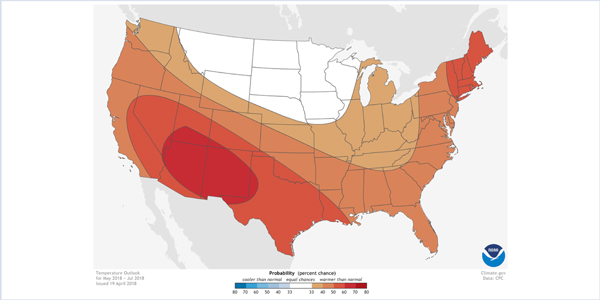By Michael Brooks
WASHINGTON — FERC will be closely monitoring ERCOT and Southern California for reliability issues this summer as most of the country faces the likelihood of above-normal temperatures, staff said at the commission’s open meeting Thursday.
Both regions lie in a portion of the Western U.S. expected to be warmer than usual, according to the National Oceanic and Atmospheric Administration. But each faces a unique challenge.
FERC’s summer reliability assessment report shows that ERCOT has a 10.92% reserve margin — compared to a 13.75% reference level — in the wake of about 4.5 GW in coal-fired generation retirements last winter and construction delays for about 2.1 GW in new resources. However, the grid operator has assured stakeholders there is no reason for alarm, noting that the current expected reserve margin is up from the 9.3% originally projected in December. (See ERCOT Gains Additional Capacity to Meet Summer Demand.)
“ERCOT expects to have sufficient operational tools to manage tight reserves and maintain system reliability,” FERC noted. “Those operational tools include deploying ERCOT-contracted load resources and emergency response services, using a previously mothballed unit expected to return to service in May 2018, requesting power across the existing DC ties, calling on generating resources that can switch between the Eastern Interconnection and ERCOT, and block-load transfers with SPP and MISO.”
Although FERC does not regulate ERCOT, Chairman Kevin McIntyre said the commission would be watching to see how the grid operator deals with any problems that arise.
Meanwhile, several disruptions to Southern California’s natural gas pipeline network mean CAISO will not be able to depend on natural gas generation to make up for a decrease in hydropower because of a lack of snowfall last winter. The state reached just 57% of normal snowpack, according to FERC, and the higher temperatures will reduce the level more quickly than normal.
Operations at the Aliso Canyon gas storage facility outside Los Angeles are still limited. While the California Public Utilities Commission last week allowed Southern California Gas to temporarily increase injections, it denied a request to increase the facility’s allowable capacity. (See CPUC OKs Temporary Increase in Aliso Canyon Injections.)
In his comments on the report, FERC Commissioner Robert Powelson said, “I am deeply troubled by California policymakers’ refusal to support Aliso Canyon as a reliable storage facility to deal with critical backup storage, not only at the [local distribution company] level, but more towards merchant power resources in the market. … We’re getting away from economic dispatch, and we’re causing tremendous cost to consumers in the California marketplace.”
Further complicating California’s situation is the anticipated near-record-breaking demand for gas across the U.S. The Energy Information Administration expects gas burn to average 35.16 Bcfd in June-August, just 0.3 Bcfd less than the record set in 2016 and 3 Bcfd more than last year, FERC said.
“The addition of over 16,000 MW of new capacity to the natural-gas fired generator fleet since the record highs in 2016 and relatively low natural gas prices contribute to expectations for strong natural gas generation this summer,” the report said. As of March 23, Henry Hub summer futures prices were $2.76/MMBtu, down 52 cents (16%) compared to last year, according to Intercontinental Exchange.
McIntyre said that “on my personal to-do list is to drill further into” whether there’s anything more FERC can do to address California’s challenges with gas.
On May 9, CAISO warned that it this summer faces a 50% chance of a Stage 2 emergency, in which customers that have signed up for incentive rates would be required to use less power during peak demand times.
FERC based much of its report on NERC’s summer reliability assessment, which hadn’t been published as of press time.





